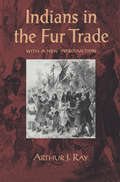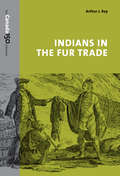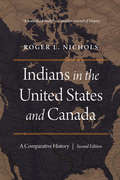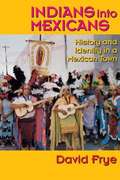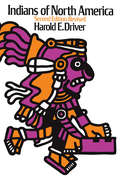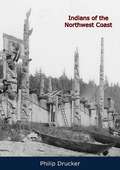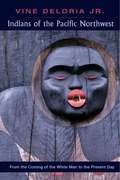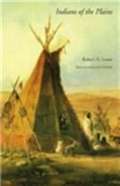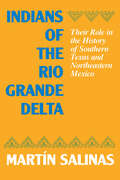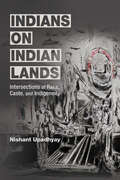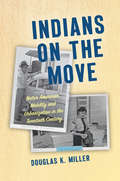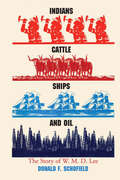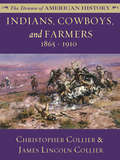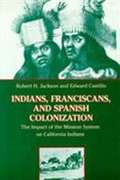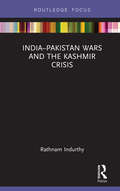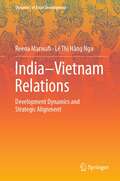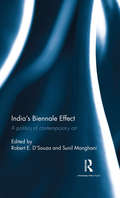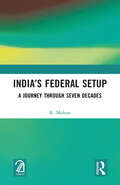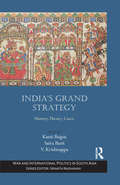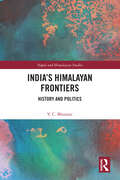- Table View
- List View
Indians in the Fur Trade
by Arthur RayFirst published in 1974, this best-selling book was lauded by Choice as 'an important, ground-breaking study of the Assiniboine and western Cree Indians who inhabited southern Manitoba and Saskatchewan' and 'essential reading for anyone interested in the history of the Canadian west before 1870.' Indians in the Fur Trade makes extensive use of previously unpublished Hudson's Bay Company archival materials and other available data to reconstruct the cultural geography of the West at the time of early contact, illustrating many of the rapid cultural transformations with maps and diagrams. Now with a new introduction and an update on sources, it will continue to be of great use to students and scholars of Native and Canadian history.
Indians in the Fur Trade: Their Roles as Trappers, Hunters, and Middlemen in the Lands Southwest of Hudson Bay, 1660-1870
by Arthur RayFirst published in 1974, this best-selling book was lauded by Choice as 'an important, ground-breaking study of the Assiniboine and western Cree Indians who inhabited southern Manitoba and Saskatchewan' and 'essential reading for anyone interested in the history of the Canadian west before 1870.' Indians in the Fur Trade makes extensive use of previously unpublished Hudson's Bay Company archival materials and other available data to reconstruct the cultural geography of the West at the time of early contact, illustrating many of the rapid cultural transformations with maps and diagrams. Now with a new introduction and an update on sources, it will continue to be of great use to students and scholars of Native and Canadian history.
Indians in the United States and Canada: A Comparative History, Second Edition
by Roger L. NicholsDrawing on a vast array of primary and secondary sources, Roger L. Nichols traces the changing relationships between Native peoples and whites in the United States and Canada from colonial times to the present. Dividing this history into five stages, beginning with Native supremacy over European settlers and concluding with Native peoples’ political, economic, and cultural resurgence, Nichols carefully compares and contrasts the effects of each stage on Native populations in the United States and Canada. This second edition includes new chapters on major transformations from 1945 to the present, focusing on social issues such as transracial adoption of Native children, the uses of national and international media to gain public awareness, and demands for increasing respect for tribal religious practices, burial sites, and historic and funerary remains.
Indians into Mexicans: History and Identity in a Mexican Town
by David FryeThe people of Mexquitic, a town in the state of San Luis Potosí in rural northeastern Mexico, have redefined their sense of identity from "Indian" to "Mexican" over the last two centuries. In this ethnographic and historical study of Mexquitic, David Frye explores why and how this transformation occurred, thereby increasing our understanding of the cultural creation of "Indianness" throughout the Americas.<P><P>Frye focuses on the local embodiments of national and regional processes that have transformed rural "Indians" into modern "Mexicans": parish priests, who always arrive with personal agendas in addition to their common ideological baggage; local haciendas; and local and regional representatives of royal and later of national power and control. He looks especially at the people of Mexquitic themselves, letting their own words describe the struggles they have endured while constructing their particular corner of Mexican national identity.
Indians of North America
by Harold E. DriverThe art of reconstructing civilizations from the artifacts of daily life demands integrity and imagination. Indians of North America displays both in its description of the enormous variation of culture patterns among Indians from the Arctic to Panama at the high points of their histories--a variation which was greater than that among the nations of Europe. For this second edition, Harold Driver made extensive revisions in chapter content and organization, incorporating many new discoveries and interpretations in archeology and related fields. He also revised several of the maps and added more than 100 bibliographical items. Since the publication of the first edition, there has been an increased interest in the activities of Indians in the twentieth century; accordingly, the author placed much more emphasis on this period.
Indians of the Northwest Coast
by Philip DruckerWritten by an outstanding authority and profusely illustrated, this is a comprehensive study of the Indians that lived from Yakutat Bay in Alaska to the northern coast of California. Originally published in the Anthropological Handbooks Series of The American Museum of Natural History, this volume vividly recreates the complexities and attainments of this unique culture of aboriginal America.The author first describes the land, people, and prehistory of the area and then considers each aspect of the culture: social structures and marriage customs, economy and technology, religion, rituals, art, wars, and feuds.Philip Drucker, an authority on the ethnology of the Pacific Coast, was educated at the University of California and was formerly with the Bureau of American Ethnology of The Smithsonian Institution in Washington, D.C.Illustrated with over 70 drawings
Indians of the Pacific Northwest
by Vine Deloria Jr. Steve Pavlik Billy Frank JrThe Pacific Northwest was one of the most populated and prosperous regions for Native Americans before the coming of the white man. By the mid-1800s, measles and smallpox decimated the Indian population, and the remaining tribes were forced to give up their ancestral lands. Vine Deloria Jr., named one of the most influential religious thinkers in the world, tells the story of these tribes' fight for survival, one that continues today. Billy Frank Jr. was the first recipient of Indian Country Today's American Indian Visionary Award. Steve Pavlik is a professor of Native American studies at Northwest Indian College.
Indians of the Plains
by Robert H. LowieRobert H. Lowie's Indians of the Plains surveys in a lucid and concise fashion the history and culture of the Indian tribes between the Mississippi and the Rocky Mountains. The author visited various tribes from 1906 to 1931, observing them carefully, participating in their lifeways, studying their languages, and listening to their legends and tales. After a half century of study, Lowie wrote this book, praised by anthropologists as the synthesis of a lifetime's work.
Indians of the Rio Grande Delta: Their Role in the History of Southern Texas and Northeastern Mexico (Texas Archaeology and Ethnohistory Series)
by Martín SalinasCertain to become a standard reference in its field, Indians of the Rio Grande Delta is the first single-volume source on these little-known peoples. Working from innumerable primary documents in various Texan and Mexican archives, Martin Salinas has compiled data on more than six dozen named groups that inhabited the area in the sixteenth through the eighteenth centuries. Depending on available information, he reconstructs something of their history, geographical range and migrations, demography, language, and culture. He also offers general information on various unnamed groups of Indians, on the lifeways of the indigenous peoples, and on the relations between the Indian groups and the colonial Spanish missions in the region.
Indians of the Rio Grande Delta: Their Role in the History of Southern Texas and Northeastern Mexico (Texas Archaeology and Ethnohistory Series)
by Martín SalinasThe first detailed archival study of the indigenous populations of the early historic period in the Lower Rio Grande Valley of Texas and Mexico. Certain to become a standard reference in its field, Indians of the Rio Grande Delta is the first single-volume source on these little-known peoples. Working from innumerable primary documents in various Texan and Mexican archives, Martín Salinas has compiled data on more than six dozen named groups that inhabited the area in the sixteenth through the eighteenth centuries. Depending on available information, he reconstructs something of their history, geographical range and migrations, demography, language, and culture. He also offers general information on various unnamed groups of indigenous people, their lifeways, and on the relations between the them and the colonial Spanish missions in the region. &“The scholarship is nothing short of superb . . . Salinas has produced the definitive work on the area, which has been needed for years.&” —Rudolph C. Troike, Professor, Department of English, University of Arizona
Indians on Indian Lands: Intersections of Race, Caste, and Indigeneity (NWSA / UIP First Book Prize)
by Nishant UpadhyayWinner of a NWSA/University of Illinois Press First Book Prize Nishant Upadhyay unravels Indian diasporic complicity in its ongoing colonialist relationship with Indigenous peoples, lands, and nations in Canada. Upadhyay examines the interwoven and simultaneous areas of dominant Indian caste complicity in processes of settler colonialism, antiblackness, capitalism, brahminical supremacy, Hindu nationalism, and heteropatriarchy. Resource extraction in British Columbia in the 1970s–90s and in present-day Alberta offer examples of spaces that illuminate the dispossession of Indigenous peoples and simultaneously reveal racialized, gendered, and casted labor formations. Upadhyay juxtaposes these extraction sites with examples of anticolonial activism and solidarities from Tkaronto. Analyzing silence on settler colonialism and brahminical caste supremacy, Upadhyay upends the idea of dominant caste Indian diasporas as racially victimized and shows that claiming victimhood denies a very real complicity in enforcing other power structures. Exploring stories of quotidian proximity and intimacy between Indigenous and South Asian communities, Upadhyay offers meditations on anticolonial and anti-casteist ways of knowledge production, ethical relationalities, and solidarities. Groundbreaking and ambitious, Indians on Indian Lands presents the case for holding Indian diasporas accountable for acts of violence within a colonial settler nation.
Indians on the Move: Native American Mobility and Urbanization in the Twentieth Century (Critical Indigeneities)
by Douglas K. MillerIn 1972, the Bureau of Indian Affairs terminated its twenty-year-old Voluntary Relocation Program, which encouraged the mass migration of roughly 100,000 Native American people from rural to urban areas. At the time the program ended, many groups--from government leaders to Red Power activists--had already classified it as a failure, and scholars have subsequently positioned the program as evidence of America's enduring settler-colonial project. But Douglas K. Miller here argues that a richer story should be told--one that recognizes Indigenous mobility in terms of its benefits and not merely its costs. In their collective refusal to accept marginality and destitution on reservations, Native Americans used the urban relocation program to take greater control of their socioeconomic circumstances. Indigenous migrants also used the financial, educational, and cultural resources they found in cities to feed new expressions of Indigenous sovereignty both off and on the reservation. The dynamic histories of everyday people at the heart of this book shed new light on the adaptability of mobile Native American communities. In the end, this is a story of shared experience across tribal lines, through which Indigenous people incorporated urban life into their ideas for Indigenous futures.
Indians, Cattle, Ships, and Oil: The Story of W. M. D. Lee
by Donald F. SchofieldIndian trader, rancher, harbor developer, oil impresario—these are the many worlds of one of the least chronicled but most fascinating characters of the American West. In the early, bustling years of the frontier, a brazen young man named William McDole Lee moved from Wisconsin to Kansas and then to Texas to forge a life for himself. Becoming a driving entrepreneurial force in Texas's development, Lee soon garnered the alliances and resources necessary to shape the financial destinies of disparate groups throughout the state. His story is expertly told in Donald F. Schofield's Indians, Cattle, Ships, and Oil. Beginning in 1869 as a trader to the southern Cheyenne and Arapaho tribes and fort provisioner to troops garrisoned at Camp Supply, Indian Territory, Lee gained a partner and amassed a fortune in short order from trading buffalo hides and robes. Vast herds of buffalo grazing on the southern plains were killed largely on his order. When buffalo were no longer a profitable commodity, Lee tackled his next challenge—the cattle trade. He began with herds branded LR that grazed on pastures near Fort Supply. Then came his LE herd in the Texas Panhandle. Another partnership, with noted cattle rancher Lucien Scott, resulted in the vast LS ranch, one of the most successful operations of its day. Lee even introduced a new breed of cattle, the Aberdeen-Angus, to the western range. But as his partnership faded, Lee moved on to his next undertaking—the development of Texas' first deep-water harbor. In 1888, Lee and other financiers put up one million dollars to finance a dream: opening international trade from the waters of the Gulf of Mexico to the mainland at the mouth of the Brazos River. Their Brazos River Channel and Dock Company was to construct, own, and operate a deep-water harbor at Velasco, with a railroad link to Houston. Though threats of financial disaster loomed large, the Velasco facility was to welcome, in its day, tugs, barges, and three-masted schooners and to provide impetus for Houston's boom. Yet with success, the mercurial Lee turned to yet another challenge—oil. Starting still another partnership, Lee committed himself to prospecting for oil on the West Columbia Ridge in Brazoria County. Lee and crew struck oil in 1907, developing one of the first producing wells of Brazoria County, but inadequate drilling equipment hampered further fruitful exploration. Lee moved his rigs to the famed Spindletop, where he perfected the technique of shallow drilling. Though spectacular success in the oil business eluded him, Lee's accomplishments set him squarely among the great entrepreneurs of the Texas oil industry. Lee's exploits led him to roles in some of the most dramatic moments in Texas and the West—Indian uprisings, buffalo hunts, political scandals, cowboy strikes and shoot-outs, railroad promotions, oil-well blow-outs and gushers. The people he encountered are the famous and infamous of western history: Cheyenne Chief Little Robe and the outlaw "Hurricane Bill" Martin; Indian Agent John D. Miles and Major General John Pope; outlaws Tom Harris and William Bonney, and Sheriff Pat Garrett. Altogether, Lee's biography vividly shows one man's manipulation of people and events during the settlement of the American frontier.
Indians, Cattle, Ships, and Oil: The Story of W. M. D. Lee
by Donald F. SchofieldIndian trader, rancher, harbor developer, oil impresario—these are the many worlds of one of the least chronicled but most fascinating characters of the American West. In the early, bustling years of the frontier, a brazen young man named William McDole Lee moved from Wisconsin to Kansas and then to Texas to forge a life for himself. Becoming a driving entrepreneurial force in Texas's development, Lee soon garnered the alliances and resources necessary to shape the financial destinies of disparate groups throughout the state. His story is expertly told in Donald F. Schofield's Indians, Cattle, Ships, and Oil. Beginning in 1869 as a trader to the southern Cheyenne and Arapaho tribes and fort provisioner to troops garrisoned at Camp Supply, Indian Territory, Lee gained a partner and amassed a fortune in short order from trading buffalo hides and robes. Vast herds of buffalo grazing on the southern plains were killed largely on his order. When buffalo were no longer a profitable commodity, Lee tackled his next challenge—the cattle trade. He began with herds branded LR that grazed on pastures near Fort Supply. Then came his LE herd in the Texas Panhandle. Another partnership, with noted cattle rancher Lucien Scott, resulted in the vast LS ranch, one of the most successful operations of its day. Lee even introduced a new breed of cattle, the Aberdeen-Angus, to the western range. But as his partnership faded, Lee moved on to his next undertaking—the development of Texas' first deep-water harbor. In 1888, Lee and other financiers put up one million dollars to finance a dream: opening international trade from the waters of the Gulf of Mexico to the mainland at the mouth of the Brazos River. Their Brazos River Channel and Dock Company was to construct, own, and operate a deep-water harbor at Velasco, with a railroad link to Houston. Though threats of financial disaster loomed large, the Velasco facility was to welcome, in its day, tugs, barges, and three-masted schooners and to provide impetus for Houston's boom. Yet with success, the mercurial Lee turned to yet another challenge—oil. Starting still another partnership, Lee committed himself to prospecting for oil on the West Columbia Ridge in Brazoria County. Lee and crew struck oil in 1907, developing one of the first producing wells of Brazoria County, but inadequate drilling equipment hampered further fruitful exploration. Lee moved his rigs to the famed Spindletop, where he perfected the technique of shallow drilling. Though spectacular success in the oil business eluded him, Lee's accomplishments set him squarely among the great entrepreneurs of the Texas oil industry. Lee's exploits led him to roles in some of the most dramatic moments in Texas and the West—Indian uprisings, buffalo hunts, political scandals, cowboy strikes and shoot-outs, railroad promotions, oil-well blow-outs and gushers. The people he encountered are the famous and infamous of western history: Cheyenne Chief Little Robe and the outlaw "Hurricane Bill" Martin; Indian Agent John D. Miles and Major General John Pope; outlaws Tom Harris and William Bonney, and Sheriff Pat Garrett. Altogether, Lee's biography vividly shows one man's manipulation of people and events during the settlement of the American frontier.
Indians, Cowboys, and Farmers: 1865 - 1910
by James Lincoln Collier Christopher CollierHistory is dramatic -- and the renowned, award-winning authors Christopher Collier and James Lincoln Collier demonstrate this in a compelling series aimed at young readers. Covering American history from the founding of Jamestown through present day, these volumes explore far beyond the dates and events of a historical chronicle to present a moving illumination of the ideas, opinions, attitudes and tribulations that led to the birth of this great nation. Indians, Cowboys, and Farmers discusses the settling of the area between the Missouri River and the Rocky Mountains and the conflicting interests of the different groups involved--the Indians, cowboys, farmers, sheepherders, and railroad barons. The authors discuss the effect of the American policy of westward expansion on the Indian population, the rise and fall of the "Cattle Kingdom," and the importance of cross-country transportation. The text is enhanced with maps, photographs, and images of historic art & artifacts.
Indians, Franciscans, and Spanish Colonization: The Impact Of The Mission System On California Indians
by Robert Jackson Edward CastilloThis ethnohistory, now in paperback, examines Indian life in the twenty-one missions Franciscans established in Alta California. In describing how the missions functioned between 1769 and 1848, the authors draw on previously unused sources to analyze change and continuity in Indian material culture and religious practices. The twin goals of Franciscans were to mold Indians into a work force that would produce surplus grain for military garrisons and to regulate their moral conduct and religious practices. The authors use production records to show the missions were quite effective in serving the economic goals. Also carefully assessed are the efforts to transform the culture and world view of Indians by delineating how they coped, their history of disease and death, and their efforts at resistance.
Indias blancas
by Florencia BonelliUn relato de amor apasionado, donde indios, blancos y mujeres cautivas entretejen una trama que perdura para siempre en la mente del lector. Florencia Bonelli, con maestría narrativa y un profundo conocimiento de la historia argentina, ofrece en Indias blancas un relato de amor apasionado, donde indios, blancos y mujeres cautivas entretejen una trama que perdura para siempre en la mente del lector. Corre el año 1873 y la sociedad porteña se consolida alrededor de las familias con apellidos ilustres. Laura Escalante, hija de un general de la Nación, es una bellísima joven con ideas claras y fuertes convicciones. Cuando viaja a Córdoba para atender a su hermano enfermo, conoce al indio ranquel Nahueltruz Guor y su vida cambia para siempre. Un amor irrefrenable, enfrentado a todos y a todo, incluso a ellos mismos, los hace transitar momentos dolorosos, llenos de aventuras, desencuentros y acción, en el marco de la épica lucha entre indios y blancos que ha definido nuestro país desde entonces.
Indias blancas 2. La vuelta del ranquel
by Florencia BonelliUn relato de amor apasionado, donde indios, blancos y mujeres cautivas entretejen una trama que perdura para siempre en la mente del lector. La batalla entre la venganza y un amor que el tiempo no consigue borrar. En 1879, Buenos Aires vive su hora más convulsionada. Roca prepara la campaña al desierto con vistas a postularse como presidente de la Nación. Laura Escalante, mujer destacada de la vida cultural y política de su ciudad, nunca ha olvidado al indio Nahueltruz Guor, convertido en el excéntrico Lorenzo Dionisio Rosas, vuelve a su tierra después de seis años para vengarse de quien lo traicionó y le rompió el corazón. El encuentro los trastornará a los dos. Nunca volverán a ser los mismos. Florencia Bonelli, con maestría narrativa y un profundo conocimiento de la historia argentina, ofrece en Indias blancas. La vuelta del ranquel un relato de amor apasionado en el cual se dirime no solo el futuro de dos personas sino el de una nación.
India–Pakistan Wars and the Kashmir Crisis
by Rathnam IndurthyThis book examines the origins of the conflict between two nuclear powers – India and Pakistan – and the instability and violence in the disputed territory of Kashmir. It presents to its readers a chronology of events and political decisions that have led to an intractable situation of the present, many decades since the stand-off between India and Pakistan started. Rathnam Indurthy traces the origins of the constant war-like situation between the two most powerful nuclear powers in South Asia through war and peace, agreements and talks, and political leaders and generals. From Indira Gandhi to Vajpayee, and from Zia-ul-Haq, Parvez Musharraf and Nawaz Sharif, the volume lays bare the various machinations on the political chessboard. It also looks at the internal issues and politics of Kashmir and offers explanations as well as solutions for the resolution of the festering impasse the two nations have reached. This volume will be of great interest to scholars and readers of foreign policy, international relations, South Asian politics, and defence and strategic studies.
India–Vietnam Relations: Development Dynamics and Strategic Alignment (Dynamics of Asian Development)
by Reena Marwah Lê Thị Hằng NgaThis book provides an in-depth analysis of the close cultural links between India and Vietnam. It discusses the issues of trade negotiations under the Regional Comprehensive Economic Partnership (RCEP) and the Indo-Pacific construct. Issues such as strengthening the economic partnership, contemporary development challenges posed by the COVID-19 pandemic, including weakening supply chains, and geo-strategic tensions are explored in this book. It enriches understanding of the potential of the two countries to develop as manufacturing hubs for the region and beyond. Given the more aggressive posturing by China in 2020, the concluding chapter includes the policy prescriptions with a futuristic vision, for India and Vietnam to catalyze their strategic and bilateral partnership. Well researched and analytical, the book draws extensively from several interviews of experts, diplomats, journalists, businesspersons, and members of the diaspora. It is a must read for students, researchers, think tanks, area study centers, and all institutions engaged in Asian studies, encompassing narratives extending from the developmental to political, from the bilateral to the multilateral and from the geo-economic to the geo-strategic.
India’s Biennale Effect: A politics of contemporary art
by Sunil Manghani Robert E. D'SouzaIndia’s Kochi-Muziris Biennale has been described as one of the most significant newly emergent biennales, alongside Shanghai, Sharjah and Dakar. However, there have been few sustained and critical studies of these events as specific sites of production and reception of contemporary art. This book, engaging with the Kochi Biennale, provides detailed examination of what the editors term as the ‘biennale effect’ — a layered contestation of place, economics, art and politics. It presents a close reading of the unique context of the biennale as well as sets out a broader critical framework for understanding global contemporary art and its effects. Replete with illustrations, this book will serve as an important and rare resource for scholars and researchers of contemporary art, art history, visual cultures, and media studies.
India’s Eurasian Alternatives in an Era of Connectivity: Historic Connects and New Corridors (Europe-Asia Connectivity)
by Anita SenguptaThe volume examines how in the twenty-first century narratives built around connectivity have become a structural component of international politics expanding into a wider array of policy fields i It examines the significance of this emerging narrative from an Indian perspective with particular reference to Eurasian alternatives. It argues that this represents the next stage of globalization and that an understanding of this is increasingly becoming crucial given the recent disruptions along with the emergence of a spate of new policies and institutions that could eventually lead to a new understanding of connectivity.
India’s Federal Setup: A Journey Through Seven Decades
by R. MohanThis book analyzes the evolution of our polity in the last seven decades by examining the developments in the economy, political events, and changing judicial perceptions. With a focus on the pertinent constitutional, political, economic, and social questions, it presents an overview of events which have influenced the evolution of federal and unitary tendencies.The subject matter of this book also discusses the emergence of coalition governments, dominance of a single party, relationships between the different tiers of the government, fiscal and economic issues, and political actions of constitutional authorities.Print edition not for sale in South Asia (India, Sri Lanka, Nepal, Bangladesh, Pakistan or Bhutan)
India’s Grand Strategy: History, Theory, Cases (War and International Politics in South Asia)
by Kanti Bajpai Saira Basit V. KrishnappaAs India prepares to take its place in shaping the course of an ‘Asian century’, there are increasing debates about its ‘grand strategy’ and its role in a future world order. This timely and topical book presents a range of historical and contemporary interpretations and case studies on the theme. Drawing upon rich and diverse narratives that have informed India’s strategic discourse, security and foreign policy, it charts a new agenda for strategic thinking on postcolonial India from a non-Western perspective. Comprehensive and insightful, the work will prove indispensable to those in defence and strategic studies, foreign policy, political science, and modern Indian history. It will also interest policy-makers, think-tanks and diplomats.
India’s Himalayan Frontiers: History and Politics (Nepal and Himalayan Studies)
by Viney C. BhutaniThis book looks at the historical and political dynamics of the Sino-Indian border dispute in India’s Himalayan Frontiers. Going back into Tibetan history, the author examines the making of the McMahon Line at Simla Conference of 1913–14. It also takes a look at some of the neighbouring areas that had interaction with Tibet, as well as the border areas of Assam and Burma, both of which were British Indian provinces. By using new archival materials, this study further goes to consider the events during the years following the defining of the McMahon Line, which, verily, did not have a sound juridical basis even if it has been regarded by scholars as a suitable boundary. It further explores different aspects of the northern frontiers of India and Sino-Indian border dispute and relations. This volume will interest scholars and researchers of history, political science and area studies, especially those interested in the geopolitics of India, China and the Himalayan region.
